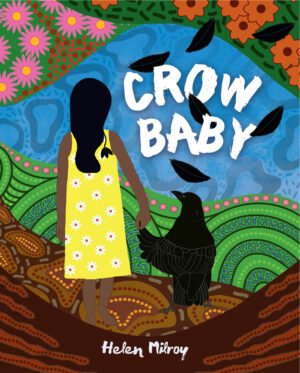The story begins long, long ago when the universe was new. A human baby and a crow are born at the same time and their two spirits merge. At the back of the baby’s head appears black hair, resembling three feathers bundled together. The crow, named Arrk, also has three feathers signifying courage, wisdom and kindness. The baby is named Daisy Crow. The community Elder explains to Daisy that she has the gift of flight through her crow spirit and that she could become a great healer. He warns Daisy she must only fly in her dreams. Arrk remains close to the baby and Daisy’s family accepts Arrk as the baby’s guardian as Crow and Daisy explore the countryside together. When Daisy is asleep at night, her crow spirit travels to visit her crow family.
One day the weather is very hot. A huge bushfire erupts and heads for Daisy’s community. How can Daisy let her community know? She cannot outrun the fire. Her only solution is to fly as her crow spirit and lead her community to the waterhole where they will be safe. Making that choice transforms Daisy into a black crow. By night Daisy returns to her human self, becomes a great healer and enjoys her family.
Themes of sacrifice, family loyalty, belonging and community provoke thought and discussion. The rich, yet simple language, evokes strong emotions and makes connections between humans and animals. The darkly coloured, patterned Aboriginal artwork offers multiple interpretations. ‘Crow Baby’ invites repeated viewing and reading as it conveys deep links between Australia’s Indigenous people, animals and landscape.
Helen Milroy says of her books, ‘It is a way of connecting children back with nature, giving them an ecological framework to recognise that we are a part of mother earth, and we are in a relationship with everything around us. Storytelling is about exploring – it is more insight-oriented, it is gentler. It helps children to develop their own views and understanding.’ (Embrace @ Telethon Kids 26 Feb 2024)
Helen Milroy is a descendant of the Palyku people of the Pilbara region of Western Australia. Her work in mental health services for youth aims to promote a sense of hope, build resilience and help develop a relationship with place.

